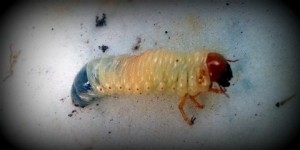All of us need bugs to live. As well as being a part of our own personal ecosystem, bugs are an essential part of the process which allows our gardens to grow and thrive. From the bees and other creatures that pollinate our crops to the ladybugs that eat those sap sucking aphids, we can’t live, eat or garden without them. So how do we encourage the good bugs and protect against the nasties? Well, first, it’s about understanding what’s going on in our garden, and importantly, just who’s living in it!
To help me get to know my garden bugs a bit better, I called on IPM Technologies.
Noel Jansz from Elders put me in touch with Dr Paul Horne from IPM technologies. He and his company tend to not work with someone my size. When I told him I would lose weight, he said, “no. I meant the size of your farm”. However, he made an exception for me because he hopes through my farm example, we might be able to encourage people to reconsider their reaction to bugs. He flew up from Victoria and we went for a stroll through my garden in August. What an eye-opener for me!
Firstly, there was plenty of evidence of invading forces, aphids, grubs, chewed leaves… the usual stuff. I immediately went for the organic, low toxic Dipel, to stave off the invasion, but Paul pointed out that amongst the living aphids, there were shells of aphids; a kind of hollowed out white aphid, which was evidence that a predator had found the colony and the business of eating, or rather sucking dry, aphids had begun. “Why would predators appear if there was nothing for them to eat? We need to give Mother Nature time to start its cycle.” Makes sense, doesn’t it? So from that day on, I began my hectic schedule of doing nothing and it’s paid off. My only intervention has been a saving spray of Dipel on the Bairnsdale cabbages which, were a playground for cabbage moth caterpillars. The balance had swung too far towards the caterpillars and the wasps and other predators couldn’t keep up. I will be watching closely to see if the next wave of caterpillars will be managed without sticking my nose in. I was always a farmer who prided myself on”knowing every leaf in the patch.” Now, however, I know the leaf as well as the colonies and battles fought around them. This adds another layer to my farming awareness.
There has been a steady stream of photos of unidentified bugs sent to Paul who has taken the alarm out of my crawling discoveries.
This little critter – a scarab beetle (which was found whilst bed forming the veggie garden) is on its way to Dr Paul Horne for formal identification and further examination.

